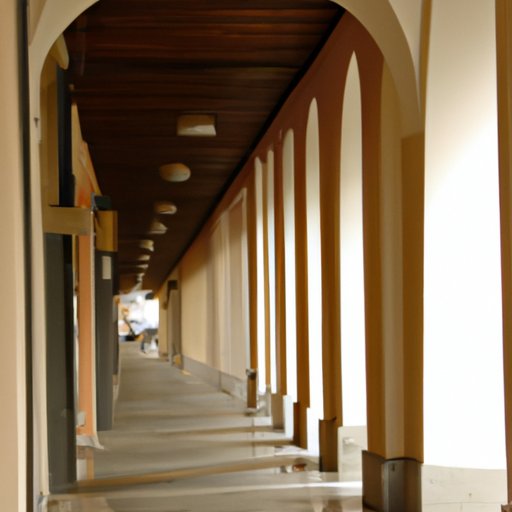Introduction
An arcade is a series of connected arches or vaults that form a passageway, often found in public structures such as churches and shopping malls. In architecture, arcades have been used since ancient times to create sheltered walkways and to provide support for larger structures. This article will explore the history and development of arcades in architecture, examine their role in contemporary buildings, and investigate how architects use arcades to create unique spaces.
Overview of the History and Development of Arcades in Architecture
Arcades have been used in architecture since ancient times. In Ancient Rome, they were used to construct aqueducts and other large public works. During Medieval times, they served as covered walkways in castles and monasteries. In the Renaissance period, the revival of classical architecture led to the widespread use of arcades in churches and palaces. During the 19th century, arcades became popular in urban areas, providing sheltered walkways for shoppers and pedestrians. Today, arcades are still used in many modern buildings, including shopping malls, museums, and office buildings.

Exploring the Role of Arcades in Contemporary Buildings
Arcades serve several important functions in contemporary buildings. Structurally, they provide support for walls and roofs and can be used to span large spans without the need for additional columns or beams. Aesthetically, arcades can add visual interest to a building, creating a sense of grandeur and elegance. Practically, arcades can protect pedestrians from the elements and provide access to different levels of a building.

Understanding the Aesthetic and Practical Benefits of Incorporating Arcades into Design
When designing a building, incorporating arcades into the plan can provide both aesthetic and practical benefits. Visually, arcades can enhance the look of a structure, creating an inviting atmosphere and providing a sense of space. Functionally, arcades can open up a building, creating open spaces and improving accessibility. By understanding the advantages of arcades, architects can benefit from incorporating them into their designs.
Examining the Different Types of Arcades Used in Structures
There are several different types of arcades that can be used in architectural designs. Corbel arches are constructed by stacking stones in a vertical pattern, with each stone overlapping the one below it. Lateral arches are built using two rows of stones set at an angle, with the top row resting on the bottom row. Groin vaults are constructed from two intersecting barrel vaults, forming a pointed arch. Barrel vaults are curved arches that span a wide area, often used in churches and other large structures.

Investigating How Architects Use Arcades to Create Unique Spaces
By incorporating arcades into their designs, architects can create unique spaces that are both aesthetically pleasing and functional. Arcades can be used to connect interior and exterior spaces, creating a seamless transition between the two. They can also be used to define areas within a building, utilizing distinctive styles and colors to create distinct zones. Finally, architects can use texture and color to add interest to arcades, creating a visually appealing environment.
Conclusion
Arcades have been used in architecture for centuries, providing structural support and aesthetic appeal. When incorporated into a design, arcades can open up a building, creating open spaces and enhancing visual appeal. There are several different types of arcades, each offering its own unique benefits. By exploring the possibilities with arcades, architects can create unique and interesting spaces that are both aesthetically pleasing and practical.
(Note: Is this article not meeting your expectations? Do you have knowledge or insights to share? Unlock new opportunities and expand your reach by joining our authors team. Click Registration to join us and share your expertise with our readers.)
